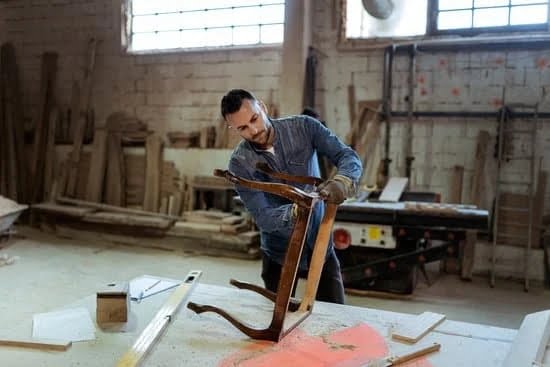Chestnut woodwork holds a timeless appeal due to its rich history and distinctive characteristics. This article aims to provide readers with the knowledge and tools necessary to identify and appreciate chestnut woodwork. From its unique grain patterns, color, and texture to the various visual cues that distinguish it from other types of woodwork, understanding these features is essential in accurately identifying chestnut wood.
Chestnut woodwork has long been valued for its historical significance. In the past, American chestnut trees were abundant throughout the eastern United States, making chestnut wood a popular choice for construction and furniture-making. However, an blight fungus devastated the American chestnut population in the early 20th century, making true American chestnut wood rare and highly sought after today. It is this scarcity that adds to the allure of chestnut woodwork and makes identifying it all the more important.
Beyond its historical significance, understanding the characteristics of chestnut woodwork is crucial for accurate identification. Chestnut typically displays a warm brown hue with subtle tones of red or gold. Its grain pattern varies from straight to wavy, often featuring prominent rays that lend depth and character to the finished piece. Additionally, knots can be present in chestnut woodwork, giving it a distinct rustic charm. Identifying these unique traits will greatly assist in distinguishing chestnut wood from other similar-looking materials.
By delving into the allure and historical significance of chestnut woodwork, we lay the groundwork for further exploration into understanding how to identify this exquisite material. The subsequent sections will delve deeper into its defining characteristics, visual cues, patina development over time, cross-section analysis techniques, construction methods used specifically for chestnuts works along with common mistakes made while attempting identification.
With this comprehensive guide at hand, readers can confidently assess whether they have encountered masterful pieces of genuine chestnut woodwork or need further assistance from experts or reference materials.
Understanding the Characteristics of Chestnut Woodwork
Chestnut woodwork possesses several distinctive characteristics that make it easily identifiable. Understanding these unique grain patterns, color variations, and textures can help individuals accurately identify chestnut woodwork.
One of the most notable features of chestnut woodwork is its grain pattern. Chestnut generally displays a straight grain, but it can occasionally exhibit irregular patterns or interlocking grains. This distinctive grain pattern adds depth and visual interest to the woodwork, making it stand out from other types of wood.
In terms of color, chestnut woodwork often has warm tones ranging from light to medium brown. It can also feature reddish hues or even darker shades due to aging and exposure to sunlight. The natural color variations in chestnut make each piece of furniture or architectural element unique and visually appealing.
Texture is another key characteristic of chestnut woodwork. It typically has a medium to fine texture with a low natural luster. The smooth surface of chestnut allows for easy finishing and polishing, enhancing its natural beauty.
| Characteristic | Description |
|---|---|
| Grain Pattern | Straight with occasional irregular patterns or interlocking grains |
| Color | Warm tones ranging from light to medium brown; reddish hues; darkening with age and sun exposure. |
| Texture | Medium to fine texture with a low natural luster; smooth surface ideal for finishing. |
Overall, being able to identify the distinct characteristics of chestnut woodwork is essential for appreciating its historical significance and preserving its legacy in woodworking traditions.
Identifying Chestnut Woodwork through Visual Cues
Chestnut woodwork possesses distinct visual cues that can help in its identification. By understanding these unique features, one can accurately discern whether a piece of woodwork is made from chestnut.
Prominent Rays
One visual cue commonly found in chestnut woodwork is the presence of prominent rays. Rays are linear structures within the wood that run perpendicular to the growth rings. In chestnut, these rays appear prominently on the surface and are often wider and more pronounced compared to other types of wood. This feature gives chestnut woodwork a distinctive and eye-catching appearance.
Knots
Knots are another characteristic feature to look for when identifying chestnut woodwork. Chestnut trees, particularly the American chestnut, were known for their large and abundant knots. These knots create irregularities in the grain pattern and add an element of natural beauty to the woodwork. They can range in size, shape, and color, making them easily recognizable when inspecting a piece of furniture or architectural element.
Wormholes
Wormholes are small tunnels made by insects during the tree’s life or after it has been felled. Chestnuts logs were particularly susceptible to insect infestations due to their high sugar content, which attracted pests like beetles and termites.
As a result, wormholes are often present in chestnut woodwork and can be used as a visual clue to identify it. These tiny holes vary in size and may appear scattered or concentrated in certain areas depending on the extent of infestation.
By paying attention to these distinctive features such as prominent rays, knots, and wormholes, individuals can develop an eye for identifying chestnut woodwork at first glance. However, it is important to note that factors such as age, exposure to elements, and craftsmanship techniques may affect the appearance of these visual cues over time. Therefore, it is essential to consider these features in conjunction with other methods of identification, such as conducting a cross-section analysis or examining construction techniques.
The Importance of Patina in Identifying Chestnut Woodwork
Chestnut woodwork is not only valued for its unique grain patterns, color, and texture but also for the patina that develops over time. Patina refers to the natural aging process that wood undergoes as it is exposed to light, air, and moisture. This process can take decades or even centuries, resulting in a distinct appearance that can help identify chestnut woodwork.
Understanding the Aging Process
As chestnut wood ages, it undergoes various changes that contribute to the development of its patina. One significant factor is oxidization, where the wood reacts with oxygen in the air. Over time, this reaction deepens the color and adds richness to the overall appearance of the woodwork. This transformation can give chestnut wood a warm amber hue or a deeper reddish-brown tone.
Another component of the aging process is exposure to sunlight. Ultraviolet (UV) rays from sunlight break down certain components within the wood, causing it to darken further and develop a weathered look. This exposure can also result in an uneven distribution of color across different parts of the woodwork, depending on how much light they received over time.
Distinctive Markings and Features
The patina on chestnut woodwork often highlights its distinctive markings and features. As mentioned earlier, chestnut wood exhibits prominent rays that appear as long streaks or flecks across its surface. These rays become more pronounced as the patina develops, enhancing their visibility and adding depth to the overall appearance.
Additionally, wormholes are commonly found in aged chestnut woodwork due to infestations by beetles and other wood-boring insects during its lifespan. These small holes create an interesting visual texture that becomes more apparent with time and further contributes to the uniqueness of chestnut woodwork’s patina.
The Significance of Patina in Identification
The presence of a distinct patina can be a strong indicator that the woodwork is made of chestnut. While other types of wood may develop patina as well, the specific combination of color, grain patterns, and distinctive features found in chestnut woodwork sets it apart. Therefore, when evaluating a piece for its authenticity or identifying the type of wood used, examining the patina can provide valuable clues.
Conducting a Cross-Section Analysis to Confirm Chestnut Woodwork
To accurately identify chestnut woodwork, one effective method is conducting a cross-section analysis. This process involves taking a small sample of the wood and examining it under a microscope to determine the presence of chestnut wood. By closely observing the characteristics of the sample, such as grain patterns and cell structures, experts can confirm whether or not the material is indeed chestnut.
The first step in conducting a cross-section analysis is obtaining a small sample from the piece of woodwork in question. It is important to choose an inconspicuous spot that will not significantly impact the overall appearance or integrity of the piece. A sharp knife or chisel can be used to carefully extract a thin slice from both end grain and face grain areas.
Once a suitable sample has been obtained, it is necessary to examine it under a microscope with adequate magnification. The goal is to observe specific features that are indicative of chestnut woodwork. These may include distinct medullary rays, which are radiating lines that appear perpendicular to growth rings, as well as areas with knots and wormholes known for their characteristic appearances on chestnut wood.
During the examination, comparison with reference materials or samples from known chestnut wood sources can be helpful in confirming identification. Additionally, experts may use staining techniques or chemical tests to further discern if the sample matches known characteristics of chestnut wood.
Conducting a cross-section analysis offers an objective and scientific approach for determining whether a piece of woodwork is made from chestnut. Combining this method with other visual cues and construction techniques can provide strong evidence in identifying this unique type of woodwork accurately.
Examining Woodwork Construction Techniques
Woodwork construction techniques provide valuable insights into identifying chestnut woodwork. The unique joining methods, carving styles, and historic uses associated with chestnut wood can offer important clues for distinguishing it from other types of wood.
One characteristic of chestnut woodwork is its distinctive joinery techniques. Traditional chestnut furniture often features the use of mortise and tenon joints, which involve a protruding piece (the tenon) fitting into a corresponding hole (the mortise).
These joints are typically tight-fitting and durable, demonstrating the craftsmanship and skill involved in creating chestnut wood pieces. Examining the construction of a piece of furniture or woodworking project can give us insight into whether it is made from chestnut or another type of wood.
Another aspect to consider when identifying chestnut woodwork is its carving style. Chestnut wood is known for being relatively easy to carve due to its straight grain and medium texture.
This has led to the creation of intricate designs and decorative embellishments on many chestnut wood pieces throughout history. Examine any ornate carvings or detailing on a piece and compare them to documented examples of carved chestnut woodwork to help determine if it is indeed made from this particular type of wood.
The historic uses of chestnut wood can also aid in identification efforts. Historically, due to its durability, resistance to rot, and abundance in certain regions, chestnut was commonly used for outdoor applications such as fencing, siding, barns, and decks.
If you come across an old building or structure that exhibits these characteristics along with other visual cues discussed earlier in the article such as grain patterns or wormholes indicative of chestnuts natural attributes, there may be a high chance that it is constructed using this distinctive type of wood.
By examining the unique joining methods, carving styles, and historic uses of chestnut woodwork, individuals can improve their ability to identify this valuable and historically significant material. It is important to remember that identifying chestnut woodwork may require a combination of visual cues, construction techniques, and expert opinions or resources to make a definitive determination. Understanding these factors will not only enhance the appreciation for chestnut woodwork but also contribute to its preservation for future generations to enjoy.
Utilizing Expert Opinions and Resources
One of the most effective ways to accurately identify chestnut woodwork is by utilizing expert opinions and resources. Consulting professionals, antique dealers, and reference materials can provide valuable insights and knowledge that can aid in the identification process.
1. Consulting Professionals:
Seeking the expertise of professionals such as carpenters, woodworkers, or restoration specialists can be immensely helpful when trying to identify chestnut woodwork. These individuals possess a deep understanding of different wood species, including chestnut, and can provide expert opinions based on their experience and knowledge. They may be able to recognize specific characteristics and features that are indicative of chestnut woodwork, helping to confirm or refute your assessment.
2. Antique Dealers:
Antique dealers are well-versed in various types of woodwork and can provide valuable guidance in identifying chestnut pieces. Their extensive experience handling antique furniture and decorative items gives them a trained eye for identifying different woods. They often have access to databases or resources that catalog specific characteristics and styles associated with different periods or regions, which can be useful in dating and identifying chestnut woodwork.
3. Reference Materials:
Utilizing reference materials such as books, articles, online resources, or even woodworking catalogs dedicated to identifying different types of wood can greatly assist in the identification process. These materials typically include detailed descriptions along with high-quality images of various woods patterns and grains. By comparing these visuals to the piece you are examining, you can gain a better understanding of whether it is made from chestnut or another type of wood.
By utilizing expert opinions from professionals, seeking guidance from antique dealers, and referring to reliable reference materials, individuals interested in identifying chestnut woodwork can significantly enhance their accuracy. It is important to remember that while visual cues play a significant role in identification, only experts trained through experience can reliably determine if a piece is truly made from chestnut wood. Therefore, always consult multiple sources before drawing conclusions about the authenticity of chestnut woodwork.
Common Mistakes and Misconceptions in Identifying Chestnut Woodwork
Identifying chestnut woodwork can be a challenging task, and there are several common mistakes and misconceptions that individuals may encounter along the way. Understanding these prevalent misconceptions and errors is crucial in accurately identifying chestnut woodwork.
One common mistake is assuming that all old woodwork is made from chestnut. While it is true that chestnut was widely used in construction prior to the early 20th century, other woods such as oak, pine, and walnut were also commonly used during that time period. Therefore, it is important to consider multiple factors when attempting to identify chestnut woodwork.
Another misconception is that all chestnut woodwork will have a distinct reddish hue. Although chestnut does tend to have a reddish-brown color, this can vary depending on factors such as age, exposure to sunlight, and finishes applied over time. Chestnut woodwork can range from light brown to dark brown, so it is important to consider the overall color spectrum when trying to identify it.
Additionally, some individuals may mistakenly believe that wormholes are only present in chestnut wood. While wormholes are indeed a distinctive feature of chestnut due to the tree’s vulnerability to insects, they can also be found in other types of woods. Therefore, it is essential not to solely rely on the presence of wormholes when attempting to identify chestnut woodwork.
To avoid these common mistakes and misconceptions, it is recommended to consult professionals or reference materials specializing in woodworking or antique furniture. Antique dealers who specialize in historic woodworking can provide valuable insights and expertise in identifying different types of wood. Additionally, reference books or online resources dedicated to woodworking can offer detailed descriptions and visual examples for comparison.
By addressing these prevalent misconceptions and errors, individuals can enhance their knowledge and understanding of how to accurately identify chestnut woodwork. Appreciating the historical significance and unique characteristics of chestnut woodwork not only preserves its legacy but also enriches our understanding of woodworking craftsmanship throughout history.
Conclusion
In conclusion, identifying chestnut woodwork requires a keen eye for its unique characteristics and a comprehensive understanding of its historical significance. Throughout this article, we have explored the distinct grain patterns, color variations, and texture that make chestnut woodwork stand out. We have also discussed visual cues such as prominent rays, knots, wormholes, and the importance of patina in determining if the piece is made from chestnut.
Furthermore, conducting a cross-section analysis and examining construction techniques can provide further confirmation of the presence of chestnut wood. By consulting with experts, antique dealers, and reference materials, individuals can gain valuable insights and guidance in accurately identifying chestnut woodwork.
It is important to remember that identifying chestnut woodwork is not always easy, as there are common mistakes and misconceptions that one may encounter. However, with proper research and attention to detail, it is possible to distinguish genuine chestnut woodwork from imitations or other types of wood.
Frequently Asked Questions
How can you tell if wood is chestnut?
Determining whether wood is chestnut can be done through visual examination and knowledge of its distinct characteristics. Chestnut wood is typically light to medium brown in color, with a smooth texture and straight grain that often contains fine lines known as “rays.”
Additionally, chestnut may exhibit natural imperfections such as knots or wormholes, giving it a unique appearance. To further confirm its identity, one can also consider the location where the wood was sourced, as chestnut trees are predominantly found in certain regions.
Does chestnut wood look like oak?
While both chestnut and oak are hardwoods commonly used in woodworking, they do have noticeable differences in appearance. Chestnut wood has a lighter color tone compared to oak, ranging from pale brown to reddish-brown hues. Oak, on the other hand, tends to have a darker and richer coloration, often displaying shades of golden-brown or even deep brown.
Additionally, oak grains are typically more pronounced with prominent patterns and pores, while chestnut has a smoother and more uniform grain pattern. Therefore, although there may be some similarities between the two woods, experienced eyes can easily differentiate them based on these distinguishing features.
How valuable is chestnut wood?
The value of chestnut wood varies depending on various factors, including its age, quality, condition, and current market demand. Historically speaking, chestnut used to be highly valued for its durability and resistance to rot and decay – qualities that made it popular for outdoor applications like fencing or barn construction. However, due to the devastating impact of the chestnut blight disease during the early 20th century that wiped out many American chestnuts (Castanea dentata), true ancient chestnut wood has become increasingly rare and valuable today.
Recycled or reclaimed chestnut lumber salvaged from old buildings or furniture can also fetch high prices due to its historical significance and unique character derived from years of aging and weathering processes. Nevertheless, determining the precise monetary value would require a detailed assessment of the specific wood, its condition, and the current market conditions.

Hi everyone! I’m a woodworker and blogger, and this is my woodworking blog. In my blog, I share tips and tricks for woodworkers of all skill levels, as well as project ideas that you can try yourself.





